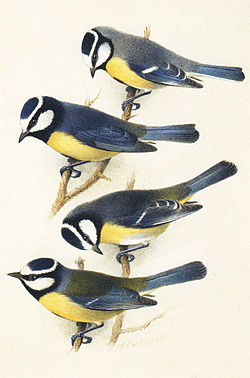African blue tit
| African blue tit | |
|---|---|
 | |
| Scientific classification | |
| Domain: | Eukaryota |
| Kingdom: | Animalia |
| Phylum: | Chordata |
| Class: | Aves |
| Order: | Passeriformes |
| Family: | Paridae |
| Genus: | Cyanistes |
| Species: | C. teneriffae |
| Binomial name | |
| Cyanistes teneriffae (Lesson, 1831) | |
 | |
| Synonyms | |
| Parus teneriffae Lesson, 1831 | |
The African blue tit (Cyanistes teneriffae) is a species of bird in the family Paridae. It is found in northern Africa, Pantelleria (Italy) and the Canary Islands (Spain). Its natural habitat is temperate forests. This species and the Eurasian blue tit were formerly considered conspecific. The status of this species has not been assessed because it is noted to be common on the islands of Tenerife and Gran Canaria. The species has been used in many research studies due to its island populations and relevance to evolutionary hypotheses.[2]
Location
[edit]The African blue tit is found in Northern Africa, Pantelleria and the Canary Islands. It is widespread on the Islands of Tenerife and Gran Canaria, but scarce in local populations on Fuerteventura and Lanzarote.[3]
Description
[edit]The African blue tit ranges from 11–12 cm (4.3–4.7 in) in size.[3] It is a small, sharp-billed, compact tit. The nominate race has a forehead and supercilium to centre of nape white, crown deep glossy blue, becoming blackish on the neck, with a blue dorsal and yellow ventral body. The song is a variable repetition of one or two notes.[3]
Diet
[edit]The species is known to consume a variety of caterpillars.[4] The diet is not significantly different from the Eurasian blue tit.
Habitat
[edit]The African blue tit prefers temperate forests, both low and high lying.[3][4] Lowlands area preferred on Fuerteventura and Lanzarote, but populations on Tenerife and Gran Canaria prefer montane forests.
Breeding
[edit]The species breeds from February to July, and also possibly from October to January. It usually breeds earlier at lower levels compared to in montane areas.[4] Egg-laying occurs when the photoperiod is longer, and extra-pair mates are chosen and synchronises with the highest density of caterpillars available for prey.[4] This is a resident species—juveniles remain at their natal site; they do not disperse once they fledge.[3]
Taxonomy
[edit]

Green: teneriffae
Brown: palmensis
Blue: ombriosus
Purple: hedwigii
Yellow: degener
This species and the Eurasian blue tit were formerly considered conspecific.
Subspecies are:[2]
- C. t. palmensis – Palma blue tit – La Palma, in NW Canary Is.
- C. t. ombriosus – El Hierro (SW Canaries)
- C. t. teneriffae – Canary blue tit – La Gomera and Tenerife, in WC Canary Is.
- C. t. hedwigii – Gran Canaria, in C Canary Is.
- C. t. degener – Lanzarote and Fuerteventura, in E Canary Is.
- C. t. ultramarinus – Ultramarine tit – Pantelleria (Italy), NW Africa from Morocco E to N Tunisia
- C. t. cyrenaicae – Libyan blue tit – NE Libya. Endemic to the local[clarification needed] mountains and forests, this is often regarded as a separate species and should be officially separated into a different distinct species: Cyanistes cyrenaicae.[5]
- The Canary Islands' subspecies has a black cap, and the African form has a blue back. Research is underway to split these populations into distinct species, with a peculiar "leapfrog" distribution.[6][7][8] Research published in 2007 found that African blue tits on the eastern Canary Islands of Fuerteventura and Lanzarote are indistinguishable from those in North Africa and so the subspecies degener should be regarded as a synonym of ultramarinus.[9]
References
[edit]- ^ BirdLife International (2016). "Cyanistes teneriffae". IUCN Red List of Threatened Species. 2016: e.T103761672A104117708. doi:10.2305/IUCN.UK.2016-3.RLTS.T103761672A104117708.en. Retrieved 19 November 2021.
- ^ a b Illera, Juan Carlos; Spurgin, Lewis G.; Rodriguez-Exposito, Eduardo; Nogales, Manuel; Rando, Juan Carlos (June 2016). "What are We Learning about Speciation and Extinction from the Canary Islands?". Ardeola. 63 (1): 15–33. doi:10.13157/arla.63.1.2016.rp1. ISSN 0570-7358.
- ^ a b c d e "African blue tit (Cyanistes teneriffae)". www.hbw.com. Retrieved 2018-10-31.
- ^ a b c d Ziane, Nadia; Chabi, Yassine; Lambrechts, Marcel M. (December 2006). "Breeding Performance of Blue TitsCyanistes caeruleus ultramarinusin Relation to Habitat Richness of Oak Forest Patches in North-Eastern Algeria". Acta Ornithologica. 41 (2): 163–169. doi:10.3161/068.041.0201. ISSN 0001-6454.
- ^ https://lntreasures.com/libya.html
- ^ Kvist, Laura (2006). "Response to "Taxonomic status of 'phylogroups' in the Parus teneriffae complex (Aves)" by George Sangster". Molecular Phylogenetics and Evolution. 38 (1): 290. doi:10.1016/j.ympev.2005.10.012.
- ^ Kvist, Laura; Broggi, J.; Illera, J.C; Koivula, K. (2005). "Colonisation and diversification of the blue tits (Parus caeruleus teneriffae-group) in the Canary Islands". Molecular Phylogenetics and Evolution. 34 (3): 501–511. doi:10.1016/j.ympev.2004.11.017. PMID 15683925.
- ^ Sangster, George (2006). "Taxonomic status of 'phylogroups' in the Parus teneriffae complex (Aves): Comments on the paper by Kvist et al. (2005)". Molecular Phylogenetics and Evolution. 38 (1): 288–289. doi:10.1016/j.ympev.2005.10.009. PMID 16314112.
- ^ Dietzen, Christian; Garcia-del-Rey, Eduardo; Delgado Castro, Guillermo; Wink, Michael (January 2007). "Phylogeography of the blue tit (Parus teneriffae-group) on the Canary Islands based on mitochondrial DNA sequence data and morphometrics". Journal of Ornithology. 149 (1): 1–12. doi:10.1007/s10336-007-0192-7.


 French
French Deutsch
Deutsch